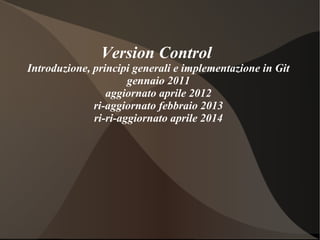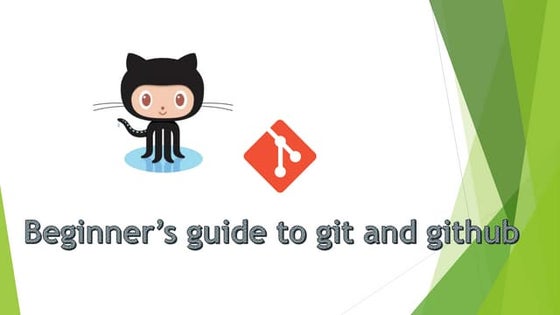Controllo di versione e Git
- 1. Version Control Introduzione, principi generali e implementazione in Git gennaio 2011 aggiornato aprile 2012 ri-aggiornato febbraio 2013 ri-ri-aggiornato aprile 2014
- 2. Di che si parla? ŌŚÅ Quando un progetto software diventa complesso, anche la sua gestione ├© complicata ŌŚÅ Il controllo revisioni permette di gestire tutte le modifiche apportate ai documenti del progetto, archiviando tutte le versioni del progetto sin dal suo inizio ŌŚÅ Ecco cosa si pu├▓ fare...
- 3. E se non lo uso? ŌŚÅ E' un mondo libero, e ciascuno ├© libero di sbagliare nel modo che preferisce. ŌŚÅ MA questo ├© quello che pu├▓ succedere..
- 4. Metodologie di sviluppo... ŌŚÅ Sviluppatore singolo ŌŚÅ Pi├╣ sviluppatori ŌĆō Sviluppo con copie multiple ŌĆō Sviluppo con copia unica
- 5. Sviluppatore singolo #include<stdio.h> Int main() { int a; int b; } File.c #include<stdio.h> Int main() { int a; } File.c Ieri Oggi
- 6. Sviluppatore singolo (Problemi) ŌŚÅ Difficile recuperare le versioni pi├╣ vecchie basandosi sulla data. ŌŚÅ Difficile stabilire le differenze tra le versioni di uno stesso file.
- 7. Sviluppatori multipli (Sviluppo con copia individuale) Sviluppatore-1 Sviluppatore-2 Sviluppatore-3 PC-1 PC-2 PC-3 server
- 8. Sviluppatori multipli (Sviluppo con copia individuale) Problemi ŌŚÅ Difficile riunire i vari file modificati singolarmente. ŌŚÅ Difficile recuperare le versioni precedenti basandosi sull'utente o sulla data.
- 9. Sviluppatori multipli (Sviluppo con copia unica) Sviluppatore-1 Sviluppatore-2 Sviluppatore-3 server
- 10. Sviluppatori multipli (Sviluppo con copia unica) Problemi ŌŚÅ Impatto sul server e traffico di rete. ŌŚÅ Tempi di sviluppo lenti. ŌŚÅ Difficile recuperare le versioni precedenti, basanndosi sulla data o sull'utente. ŌŚÅ Non si possono vedere le differenze tra la versione precedente e l'attuale.
- 11. I problemi in sintesi ŌŚÅ Non c'├© modo di recuperare le versioni precedenti, basandosi sulla data o l'utente. ŌŚÅ Non c'├© modo di vedere le differenze tra le versioni. ŌŚÅ Processo di fusione versioni manuale, lento e di dubbio successo. ŌŚÅ Lunghi tempi di sviluppo.
- 12. Come risolverli? ŌŚÅ Utilizzando, ad esempio, un sistema di controllo revisione. ŌŚÅ Detto anche Versioning, o Revision Control System ŌŚÅ Revision control (also known as version control, source control or (source) code management (SCM)) is the management of changes to documents, programs, and other information stored as computer files.
- 13. Sviluppatore singolo #include<stdio.h> Int main() { int a; int b; } File.c #include<stdio.h> Int main() { int a; } File.c Ieri Stamattina Versione-1 Versione-2 Versione-3 #include<stdio.h> Int main() { int a; int b; } File.c Stasera
- 14. Sviluppatori multipli (Sviluppo in copia individuale) Sviluppatore-1 Sviluppatore-2 Sviluppatore-3 Copia di lavoro - 1 del Repository Server Repository (deposito) principale Copia di lavoro - 2 del Repository Commit (Consegna) Primo checkout (copia) dal repository del server Aggiornamentodal server Copia di lavoro ŌĆō 3 del Repository
- 15. Gestione file nel Repository Versione-1 User : user-1 Date : 24-10- 2007 Time :11:00:12 User : user-1 Date : 24-10- 2007 Time :11:00:12 User : user-2 Date : 24-10- 2007 Time :11:00:12 User : user-2 Date : 24-10- 2007 Time :11:00:12 User : user-1 Date : 24-10- 2007 Time :11:00:12 User : user-1 Date : 24-10- 2007 Time :11:00:12 User : user-3 Date : 24-10- 2007 Time :1200:12 User : user-3 Date : 24-10- 2007 Time :1200:12 User : user-2 Date : 24-10- 2007 Time :12:00:12 User : user-2 Date : 24-10- 2007 Time :12:00:12 User : user-1 Date : 24-10- 2007 Time :11:00:12 User : user-1 Date : 24-10- 2007 Time :11:00:12 User : user-2 Date : 24-10- 2007 Time :11:00:12 User : user-2 Date : 24-10- 2007 Time :11:00:12 User : user-3 Date : 24-10- 2007 Time :11:00:12 User : user-3 Date : 24-10- 2007 Time :11:00:12 User : user-1 Date : 24-10- 2007 Time :11:00:12 User : user-1 Date : 24-10- 2007 Time :11:00:12 User : user-1 Date : 24-10- 2007 Time :11:00:12 User : user-1 Date : 24-10- 2007 Time :11:00:12 User : user-2 Date : 24-10- 2007 Time :11:00:12 User : user-2 Date : 24-10- 2007 Time :11:00:12 User : user-3 Date : 24-10- 2007 Time :11:00:12 User : user-3 Date : 24-10- 2007 Time :11:00:12 Versione-2 Versione-3 Versione-4
- 16. Cosa otteniamo? Un posto dove memorizzare le varie versioni del codice (e tutti i documenti correlati) Possibilit├Ā di ŌĆ£tornare indietroŌĆØ in caso di errore e tracciare le modifiche Codice sempre aggiornato Sviluppo parallelo facilitato
- 17. 40 anni di versioning SCCS & RCS ('70) CVS (2006) Subversion (2001) GIT (2005)
- 18. SCCS e RCS ŌŚÅ SCSS: Rilasciato nel 1972, proprietario ŌŚÅ Enorme successo ŌŚÅ Base di tutti gli altri sistemi ŌŚÅ RCS: Rilasciato nel 1983, free software ŌŚÅ Lavora solo su singoli file ŌŚÅ Sintassi complessa
- 19. CVS ŌŚÅ Basato su (RCS) con informazioni addizionali ŌŚÅ Presenta per├▓ alcune lacune, tra le quali: ŌĆō Supporta solo file di testo ŌĆō Numerazione separata per ogni file ŌĆō Impossibile rinominare i file
- 20. SVN ŌŚÅ Subversion, SVN per gli amici, ├© un'evoluzione di CVS ŌĆō E' open source e gratuito (Apache Licence) ŌĆō E' molto diffuso ŌĆō E' multipiattaforma ŌĆō E' integrato in vari IDE
- 21. DRCS: Hg e Git ŌŚÅ Con l'avvento di Internet, si sviluppano i Distributed Revision Control System. ŌŚÅ Sfruttano le nuove caratteristiche dei sistemi e la rete. ŌŚÅ I pi├╣ noti sono Mercurial (Hg per gli amici) e Git. Basati su un software proprietario chiamato Bitkeeper ŌŚÅ (ma sono entrambi open source)
- 22. DRCS ŌĆō perch├® ├© meglio? Git SVN Si pu├▓ lavorare offline, perch├® il sistema ├© locale Se non c'├© rete non si pu├▓ lavorare (e si piange amaramente) Si pu├▓ portare il lavoro in una chiavetta No, non si pu├▓ Creazione semplice di una diramazione sperimentale Creare diramazioni ├© complicato Setup semplice Occorre installare o appoggiarsi a un server Non c'├© un deposito centrale e di riferimento (anche se ci si pu├▓ accordare). Tutti hanno la copia di tutto. Il server centrare contiene tutte la modifiche. Il download iniziale potrebbe essere di grandi dimensioni
- 23. Glossario ŌŚÅ Repository (deposito) Un insieme di oggetti (file) e i riferimenti necessari. Pu├▓ essere online o offline ŌŚÅ Clone (solo git) L'atto di duplicare localmente un repository ŌŚÅ Commit (lett. 'impegno', ma qui 'consegna') Invio delle modifiche effettuate al repository ŌŚÅ Checkout Copia o ripristino di una particolare versione del progetto
- 24. GIT ŌĆō il funzionamento ŌŚÅ GIT identifica tre possibili 'stati' per ogni file del progetto a cui si sta lavorando ŌŚÅ Working Copy Sono i file a cui state lavorando, che potete modificare liberamente ŌŚÅ Staging Area I file che avete modificato e che avete intenzione di ŌĆ£committareŌĆØ nel progetto definitivo ŌŚÅ Commit I file modificati
- 33. Un esempio pi├╣ pratico ŌŚÅ Vedremo il sistema applicato alla pratica ŌŚÅ Non useremo un programma, dato che funziona per tutti i tipi di file (al meglio con i file di testo) ŌŚÅ Si presume che abbiate gi├Ā installato Git (ne parleremo separatamente)
- 42. Whew! ŌŚÅ Diamo un'occhiata al log per vedere cos'├© successo. ŌŚÅ $╠²git╠²log commit╠² bb9c52540ec20eca6bb3aee5713fb24474959b6a Author:╠²Marcello╠²Missiroli╠² <prof.missiroli@gmail.com> Date:╠²╠²╠²Sun╠²Jan╠²27╠²18:09:15╠²2013╠²+0100 ╠²╠²╠²╠²Reservations:╠²start Indice del ŌĆ£commitŌĆØ. Calcolato in base al nome dell'autore, alle modiche e alla data. Commento
- 43. E pi├╣ in dettaglio... ŌŚÅ git diff HEAD app/views/users/index.html.haml @@ -3,14 +3,15 @@ -%ul{:class=>"users"} -@users.each do |user| +%table{class: "table table-striped"} + %tr + %th{:class => @name_header}= link_to 'Nome'
- 44. Ciao, sono Tim Ciao, sono TimInsieme scriveremo...Insieme scriveremo... Il Librone sacro!
- 45. $╠²git╠²remote╠²add╠²origin git://librone/sacro.git $╠²git╠²push╠²origin╠²master Protocolli utilizzabili: Git, ssh. http, local.
- 50. Branching ŌĆō merging - conflitti ŌŚÅ Finora tutte le modifiche confluiscono in un unico prodotto finale ŌŚÅ Pu├▓ essere necessario lavorare su versioni separate dei file per evitare di ŌĆ£sporcareŌĆØ il lavoro degli altri (o per altri motivi) ŌŚÅ E' opportuno creare dei branch (diramazioni) sulle quali lavorare in piena libert├Ā
- 51. Branching ŌĆō merging - conflitti ŌŚÅ Il modo consigliato di lavoro ├© proprio questo: 1) Branch & Edit Lavorate su una versione separata del codice 2) Merge Risincronizzarsi col ramo principale e risolvere conflitti 3) Commit Inviare le modifiche al repository centrale
- 57. Le branch sono utili ...ma possono diventare complicate da gestire!
- 60. Fork!
- 62. * Installazione * GitHub * Demo project Next: Workshop
- 63. GIT ŌĆō Altri Links ŌŚÅ Netbeans: ŌĆō http://www.netbeans.org ŌŚÅ GIT: ŌĆō Repository pubblici online https://github.com/ https://bitbucket.org/ ŌĆō codeschool: http://try.github.com/levels/1/challenges/1 ŌĆō The Git Book http://git-scm.com/book
- 64. Grazie ŌŚÅ Con il contributo di ŌŚÅ Anil GuptaAnil Gupta (www.guptaanil.com) ŌŚÅ Pete Nicholls (github.com/Aupajo) ŌŚÅ Armando Fox Questo documento ├© dotato di licenza CreativeCommonQuesto documento ├© dotato di licenza CreativeCommon BY-SA 3.0BY-SA 3.0 ŌŚÅ http://creativecommons.org/licenses/by-sa/3.0/deed.ithttp://creativecommons.org/licenses/by-sa/3.0/deed.it









































![$╠²git╠²commit╠²┬Łm╠²
ŌĆ£Aggiungi╠²il╠²primo╠²capitolo.ŌĆØ
[master╠²(root┬Łcommit)╠²8621aee]╠²
Aggiungi╠²il╠²primo╠²capitolo.
1╠²files╠²changed,╠²1╠²insertions(+),╠²0
deletions(┬Ł)
create╠²mode╠²100644╠²chapter1.txt
╠²](https://image.slidesharecdn.com/versioncontrolandgit-130224141450-phpapp01/85/Controllo-di-versione-e-Git-41-320.jpg)







































![[ņśżĒöłņåīņŖżņ╗©ņäżĒīģ] Red Hat ReaR (relax and-recover) Quick Guide](https://cdn.slidesharecdn.com/ss_thumbnails/redhatrearrelax-and-recoverquickguidev1-170419093210-thumbnail.jpg?width=560&fit=bounds)































































